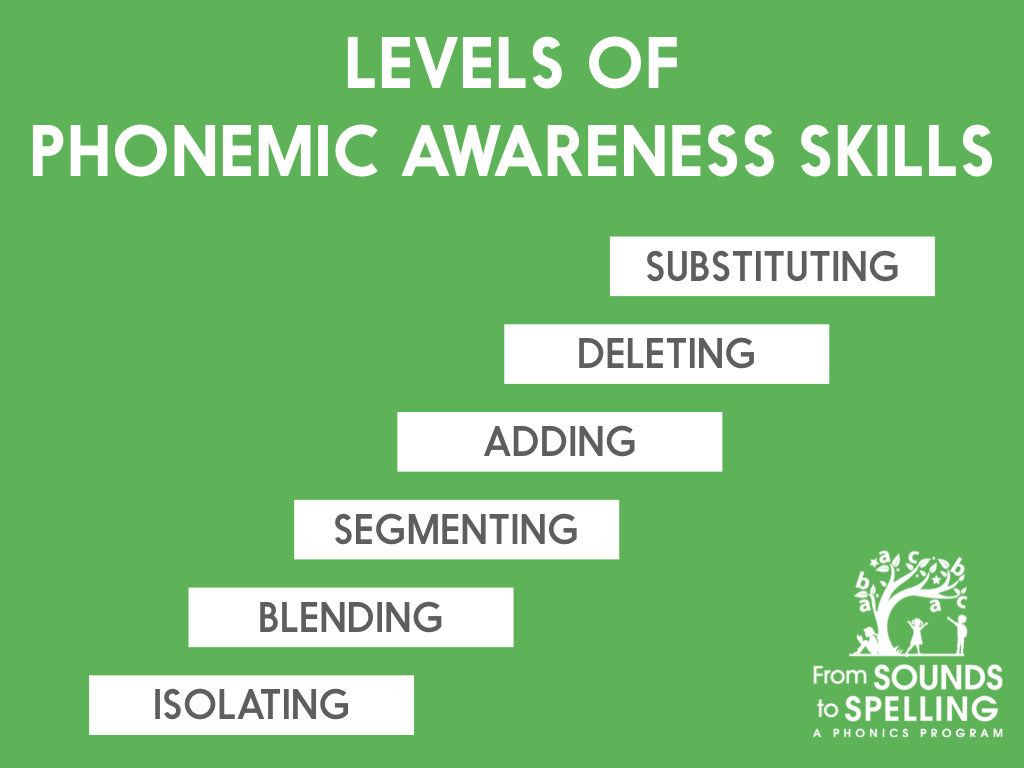
Six Levels of Phonemic Awareness: An Order for Teaching Phonemic Awareness Skills
Phonemic awareness is the awareness of individual speech sounds, like the /m/ sound in "moon" or the /ch/ sound in "beach."
Strong phonemic awareness skills are closely correlated with reading success! This is because, as students learn to read, they're connecting print (letters and groups of letters) to sounds.
We can help students develop strong phonemic awareness skills by playing quick, fun, language games with them.
For example, we might say 3 sounds aloud (/g/ /u/ /m/) and students have to say the "mystery word" (gum). This is an example of blending, one of 6 main phonemic awareness skills.
Speaking of the 6 phonemic awareness skills, here they are below:

Notice that the skills are listed at different levels - that's because some phonemic awareness skills are more difficult than others.
First, we have isolating sounds. Even though isolating sounds is the "easiest" skill, there are still levels of difficulty within this step:
- Children usually begin by learning to say the first sound in a word. For example, they might identify the first sound in the word "sun" as /s/. If that's still too difficult, you might try having students match pairs of pictures that begin with the same sound (without asking them to identify that sound yet).
- Eventually, children learn to isolate the final sound in a word (i.e. /p/ in "tap") and medial vowel sounds (i.e. /e/ in "bed" or the long o sound in "coat")
Next up, we have blending sounds. This is when we say sounds aloud and students say the entire word. If we say /u/ /p/, students must blend and say the word "up." Again, there are different levels of difficulty within blending. You might start with 2-sound words like "up" and "go," progress to 3-sound words, and eventually incorporate more challenging sounds like digraphs, blends, and diphthongs.
Then we have segmenting. Phoneme segmenting is when we say a word (i.e. "flat") and students tell us the sounds (/f/ /l/ /a/ /t/). Just like with blending, different types of words can be more or less challenging for students to segment.
Starting with the 4th step, we're now moving into what's referred to as phoneme manipulation: adding, deleting, and substituting phonemes.
Adding phonemes means having students orally add a sound to a word. We might say "The word is 'go.' Go, add /t/ to the end, and we get..." (goat) You can have students add phonemes to the beginnings or ends of words.
You can even have students insert a phoneme after the first sound to make a word with a consonant blend: "The word is gab. Gab, add /r/ after /g/, and we get..." (grab) Of course, this is challenging for many young students!
Phoneme deletion is - you guessed it - deleting or removing a phoneme. Example: "The word is 'rake.' Rake, take away /k/, and we get..." (ray) Notice that the actual spelling of the word does not matter - it's about the sounds. Read the example out loud if that helps.
Phoneme substitution is simply switching out a sound in a word. You might say, "The word is 'pat.' Say /m/ instead of /p/ and we get..." (mat).
If some phonemic awareness and/or phonics programs (like From Sounds to Spelling), you may notice that the program "skips" around a bit rather than waiting for students to fully master phoneme isolation, then blending, then segmenting, etc.
This is because students can be successful with practicing a given skill with certain words, but not others. For example, students can segment 3-sound words but they can't yet blend words with consonant blends. This might be counterintuitive because segmenting should be harder than blending, but it's completely normal because words with consonant blends are often challenging for little ones.
There are many nuances to helping students develop phonemic awareness - and you need lots of practice activities, because these skills take time to develop.
Our phonics program, From Sounds to Spelling, has a strong phonemic awareness component. The program tells you exactly how, and when, to work on these skills with your students. There's lots of flexibility to meet the needs of different students, too.
To learn more about From Sounds to Spelling and see examples of phonemic awareness and phonics activities at the Kindergarten, first grade, and second grade levels, go to FromSoundsToSpelling.com and click the "Free Trial" link.




